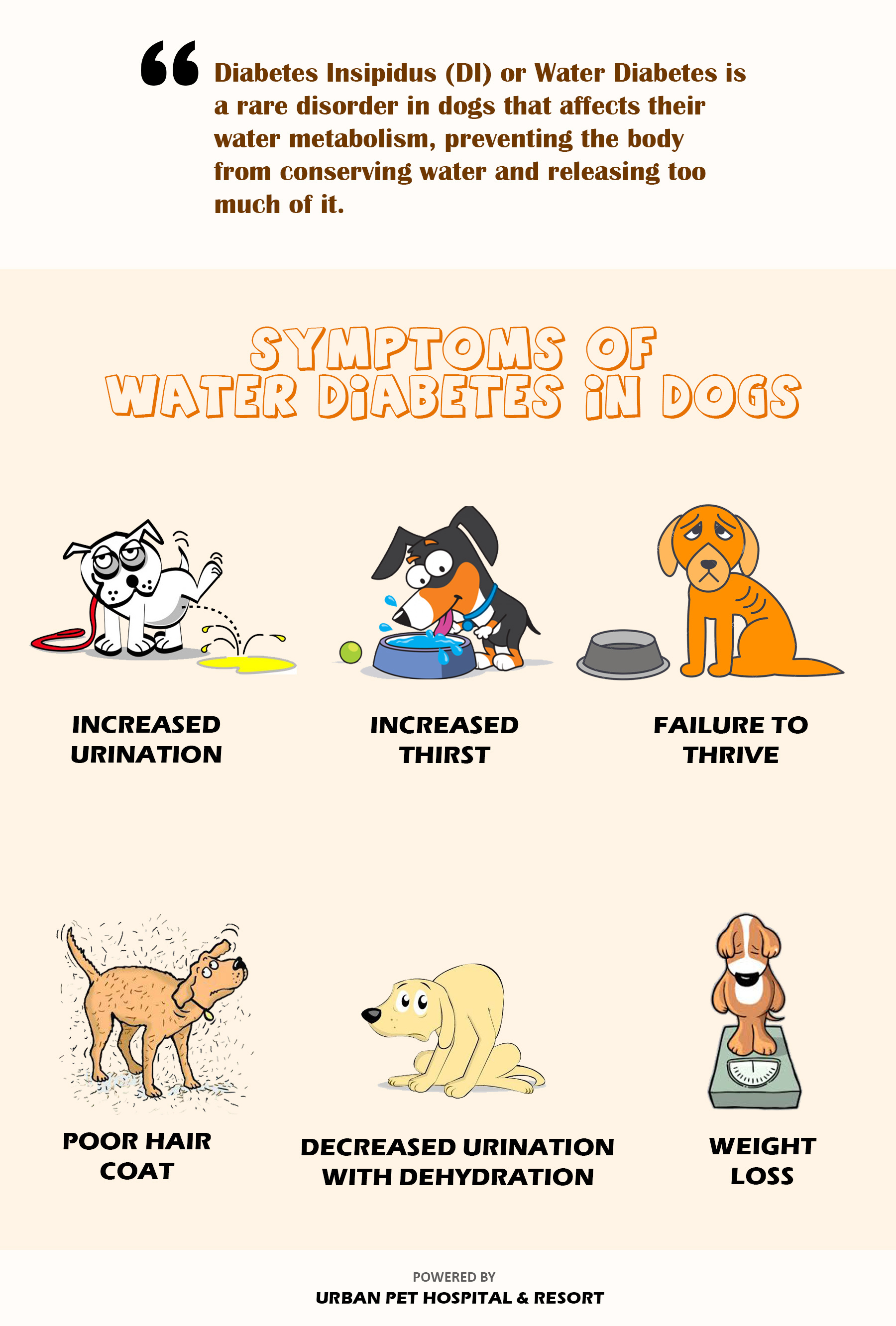Pay attention next time your dog starts drinking more water than usual and urinating frequently, or begins losing weight despite eating a healthy diet, because these signs might not just be quirks but early symptoms of diabetes. Like humans, dogs are very susceptible to developing diabetes.
A study by AVMA shows that approximately one in every 300 dogs develops diabetes during their lifetime, and rising cases of obesity and sugar-rich dog food are contributing to it significantly.
Fortunately, canine diabetes is manageable. Your furry friend with diabetes can live longer and be happier with the help of various medications, a healthy lifestyle, and specific meals.

However, before jumping onto the bandwagon, let us shed light on canine diabetes, what may cause it, and how to treat or prevent it in a timely manner.
Canine Diabetes, Types, and Symptoms
In simple terms, diabetes is a chronic disease that affects how the body uses glucose, the primary energy source for all cells. Diabetes in dogs disrupts glucose breakdown into energy, causing blood sugar levels to rise and energy-deprived cells.
The level of glucose in the blood is regulated by a hormone called insulin (made by the pancreas), without which sugar builds up in the blood and may develop diabetic symptoms.
Types of Diabetes in Dogs
There are mainly two types of canine diabetes.
1. Diabetes Mellitus (Sugar Diabetes)
Diabetes mellitus is a condition in which the body either does not produce enough insulin or cannot effectively use the insulin it produces. It is the most common type of diabetes found in dogs and is very similar to Type 1 (insulin-deficient) diabetes in humans.
Another is Type 2 (insulin-resistant) diabetes, which is more common in cats, but sometimes may occur in dogs too, usually due to obesity or hormonal imbalance.
According to the American College of Veterinary Internal Medicine (ACVIM), over 99% of diabetic dogs have insulin-dependent diabetes mellitus, meaning they will require lifelong insulin therapy.
2. Diabetes Insipidus (Water Diabetes)
Diabetes insipidus is a disorder affecting water regulation. It occurs when the kidneys fail to produce enough concentrated urine and pass too much water from the body.
When your dog’s body fails to produce an adequate amount of the hormone arginine vasopressin (AVP), also known as antidiuretic hormone (ADH), it affects several areas of the body, particularly the kidneys. It affects water metabolism, preventing the body from conserving water and causing it to release excessive amounts, quickly leading to dehydration.

Although a rare occurrence, accounting for one in 10,000 canine cases of diagnosed diabetes, it is essential to distinguish between water diabetes and sugar diabetes, as the symptoms, such as frequent urination and intense thirst, can be confusingly similar.
|
Type
|
What It Is
|
Signs to Watch
|
Treatment
|
|
Diabetes Mellitus (Sugar Diabetes)
|
The body either doesn’t produce insulin or can’t use the produced insulin properly
|
- Excessive thirst
- Frequently urinating
- Increased appetite
- Sudden decline in weight
- Eye cataracts
|
- Insulin injections
- Diabetic diet
- Routine feed and activity
- Moderate exercise
- Steady vet monitoring
|
|
Diabetes Insipidus (Water Diabetes)
|
- Deficiency or resistance to the ADH hormone
- It affects the body’s ability to conserve water
|
- Extreme thirst
- Frequent urination
- Dehydration
-Very diluted urine
-Pee accidents in the house
|
- DDAVP drops (desmopressin)
- Nephrogenic DI
- Routine feed and activity
- Always provide clean, fresh water
|
Common Risk Factors of Diabetes in Dogs
Several underlying factors can quietly increase a dog’s risk of developing diabetes. Let us take a look.
- Age - Dogs over 6 years are more likely to develop diabetes.
- Breed - Certain breeds, such as Miniature Schnauzers, Poodles, Dachshunds, and Beagles, are genetically predisposed.
- Obesity - Excess body fat can cause insulin resistance and increase the risk of diabetes.
- Gender/Hormone - Unspayed and pregnant female dogs are twice as likely to develop diabetes.
- Pancreatitis or Hypothyroidism - Inflammation or infection of the pancreas can damage insulin-producing cells.
- Cushing’s Disease - Hormonal imbalance increases blood sugar levels.
- Long-term Steroid Medications - Long-term use of corticosteroids can impair insulin function.
- Genetics - A family history of diabetes increases susceptibility to the disease.
- Diet and Infections - Poor nutrition and recurring infections can contribute to weight gain and trigger insulin resistance.
Diagnosing Diabetes in Dogs
Diagnosing diabetes in dogs is not based solely on symptoms - veterinarians may use a combination of physical exams, blood work, and urine tests:
Step 1: Complete Medical History and Physical Examination
Before any lab work, your vet will assess your complete medical history and learn about your dog’s deteriorating condition from you.
After that, the vet will perform a physical exam, checking:
- Hydration status
- Body condition score (to assess weight loss or obesity)
- Eye health (signs of cataracts)
- Skin condition (for infections or a thinning coat)
- Abdominal palpation (to detect pain or swelling)
If diabetes is suspected based on the history and examination, the veterinarian will proceed to diagnostic testing.
Step 2: Blood Glucose Test
The test is done after a 12-hour fast to avoid falsely elevated readings from recent meals.
A normal blood glucose level in dogs ranges from 75 to 120 mg/dL, but in a diabetic dog, levels often exceed 200 mg/dL.
Moreover, a single high reading is not enough to confirm diabetes, especially if the dog is stressed, as stress can temporarily raise blood sugar. That’s why the next test is also essential.
Step 3: Urinalysis (Urine Test)
A simple urine sample provides a lot of information.
What vets look for is:
- The presence of sugar in the urine (not exceeding 180 mg/dL).
- The presence of ketones.
- Signs of bacterial or white blood cell infections in the urine.
Step 4: Fructosamine Test
If there’s any uncertainty or the dog is highly stressed, your vet may order a fructosamine test, which gives a more accurate picture of your dog’s average blood sugar levels over the past two to three weeks.
Fructosamine forms when glucose bonds to proteins in the blood. A higher level means chronic high blood sugar, confirming diabetes.
Step 5: Additional Tests (If Needed)
To rule out other conditions or detect complications, the veterinarian may also perform additional tests. According to the AVMA, approximately 40% of dogs diagnosed with diabetes also have at least one concurrent health condition, which can complicate treatment if not addressed.
- Complete Blood Count (CBC): To check for infections, anemia, or inflammation.
- Serum Biochemistry Panel: To assess liver, kidney, and pancreas function.
- Thyroid Testing: Hypothyroidism can mimic some diabetic symptoms.
- ACTH stimulation or Low-Dose Dexamethasone Suppression Test: If Cushing’s disease is suspected.
- Abdominal Ultrasound or X-Rays: If pancreatitis, tumors, or other complications are suspected.
Step 6: Interpreting the Results
To officially confirm diabetes mellitus, three factors must be accurate, including:
- Persistent hyperglycemia (high glucose levels on repeated tests)
- Glucose in the urine
- Consistent symptoms or clinical signs (increased thirst, urination, and weight loss).
However, if the pet has high blood sugar but no glucose in the urine, or if the symptoms are unclear, the vet may retest in a few days or explore other potential causes, such as stress, infection, or medication side effects.
Diagnosing Diabetes Insipidus
Because diabetes insipidus is extremely rare, vets typically diagnose it only after ruling out other causes of excessive thirst and urination.
If blood glucose and urine glucose levels are normal, but your dog drinks and urinates excessively, your vet may suspect water diabetes.
To verify this rare condition, vets perform:
- Water deprivation test (carefully monitored in a clinical setting)
- Desmopressin trial (a synthetic hormone used to treat the condition)
- Imaging of the brain or pituitary gland (if a tumor is suspected)
Key Tests for Diagnosing Canine Diabetes
The veterinarian relies on various methods to diagnost the risk and severity of diabetes in dogs.
|
Tests
|
Purpose
|
Normal Value
|
Diabetic Indicator
|
|
Blood Glucose
|
Measures the sugar presence in blood
|
75-120 mg/dL
|
>200 mg/dL
|
|
Urinalysis
|
Checks for glucose, ketones, and infection
|
No glucose
|
Glucosuria, ketonuria
|
|
Fructosamine
|
Reflects average sugar levels over 2-3 weeks
|
200-285 μmol/L
|
Elevated in diabetes
|
|
CBC/Biochemistry Panel
|
Assesses overall health and organ function
|
Varies
|
Detects complications
|
|
Water Deprivation/Desmopressin (for DI)
|
Tests for DI and confirm diabetes insipidus
|
-
|
Positive DI response
|
Treating Diabetes in Dogs
Despite all odds, dogs with well-managed diabetes can expect a normal life expectancy, especially when diagnosed before complications develop.

Let's discuss them in detail.
1. Insulin Injections
Almost all dogs with diabetes mellitus require insulin injections once or twice daily.
Take your dog to the vet if near a facility. Otherwise, your vet will teach you ways to administer injections, and after a few days of practice, you will feel confident giving them to your pet at home.
- Use a syringe or insulin pen
- Administer insulin under the skin (usually near the shoulder or hip)
- Adjust dosage as needed
2. Diabetic Diet
Since the condition involves a spike in blood sugar or hypoglycemia, a balanced diet is crucial in managing blood sugar levels.
You must provide:
- High-fiber, low-fat food to slow glucose absorption
- Complex carbs like barley or oats
- Prescription diets such as Hill’s w/d or Royal Canin Diabetic
Additionally, you should avoid high-fat treats, table scraps, and sugary snacks, such as peanut butter.
3. Routine is Key
Consistency or routine behavior helps avoid dangerous sugar swings and worsening of the diabetic condition.
- Feed your dog at the same time every day
- Give insulin at a consistent time after meals
- Maintain a stable level of activity/exercise daily or weekly (as advised by vet), avoiding sudden bursts or prolonged periods of activity.
4. Moderate Exercise
Daily walks or gentle play help your dog’s body use insulin more effectively. However, avoid overexertion, especially right after insulin shots.
5. Constant Supervision
Regular vet check-ups and at-home supervision are crucial for maintaining the discipline necessary to administer medication to a diabetic dog, which includes handling insulin shots, monitoring glucose levels daily (with home glucometers), and upholding habitual practice.
Preventing Diabetes in Dogs
While not all cases are avoidable, you can take steps to reduce the risk.

Closing Thoughts
While diabetes in dogs can sound intimidating, it does not necessarily indicate a dire outcome. With a bit of extra care - proper medication, a stable routine, good nutrition, and regular vet support - your furry friend can live a whole, vibrant life.
Watch for signs, work closely with your veterinarian, and act promptly. Your dog depends on it! Contact Urban Pet Hospital & Resort for all kinds of well-facilitated veterinary services in Des Moines.